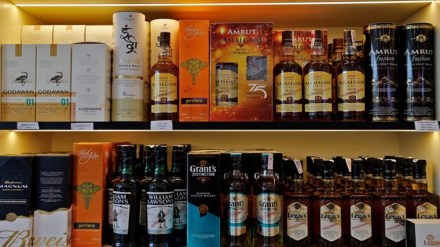Perhaps, India’s drinking habits are changing, and with that is the shape of its $ 39.30 billion (as per the Ministry of Food Processing Industries, 2024) alcohol market. Walk into any bar in Mumbai or a neighbourhood in Bengaluru, and there you will notice the shift. The shelves once stocked with regular whiskey and mass beer now hold sleeker, fancier bottles with higher price tags. This consumer upgrade isn’t subtle.
According to a September 2025 JM Financial report, the Prestige & Above (P&A) segment in Indian Made Foreign Liquor (IMFL) and the premium beer category are now growing at low double-digit rates, outpacing the mid-single-digit growth of mainstream brands. Premium IMFL already accounts for 40–45% of the category’s value, while premium beer contributes 20–25%. For an industry that sells 1.1 billion cases annually, the ripple effect is massive.
Yet, the real story isn’t that the increase in disposable income has led to consumers trading up. It’s about how this shift is affecting some of India’s largest alcobev companies, and how they are reshaping accordingly.
The climb up the shelf
The spirits segment is experiencing a dramatic transformation. The Prestige & Above segment, home to brands like Royal Challenge, American Pride, Magic Moments Dazzle and others, has been expanding at a 13-14% volume CAGR between FY18 and FY25. The broader IMFL market has been stuck in mid-single digits. As a result of this, Prestige & Above now commands nearly 45% of the IMFL space.
No company illustrates this better than United Spirits. Just three years ago, in FY22, its Prestige & Above portfolio contributed 54% of its volumes. By FY25, that share had surged to 83% of volume and 89% of sales. Within this, the Luxury and Premium sub-segments are in a league of their own, compounding at 27% from FY21 to FY25. And the payoff is stark: EBITDA per case in upper-prestige labels is up to four times higher than the company’s base spirits.
Radico Khaitan is riding a similar wave, thanks to a strategic early push into premium vodka and whisky. Its flagship brands, Magic Moments and 8 PM Premium Black, have powered a 24% CAGR in Prestige & Above sales. That momentum is set to drive overall revenue growth of 18% annually through FY25–28E, with EBITDA rising 26% and PAT climbing 36%.
Beer’s own premium turn
Beer has been slower to premiumise, but the shift is unmistakably underway. Out of the roughly 400 million beer cases consumed in India each year, 20–25% are now premium. For a market that has historically been cost-sensitive, this is a quiet but meaningful change in consumer behaviour.
United Breweries (UBL), which still controls close to half the national beer market, is steering firmly into this trend. Its premium labels, including Kingfisher Ultra Max, Heineken Silver and others, have grown at a mid-teens CAGR between FY23 and FY25, far above the low-single-digit growth of mainstream brands. UBL’s EBITDA per case for premium beer is nearly twice that of its mass offerings.
As a result, UBL is expected to deliver a 12% sales CAGR and a 29% EPS CAGR over FY25–28, alongside a 350-basis-point improvement in EBITDA margins. And it won’t be alone at the top for long. Global giants AB InBev and Carlsberg India already derive 60–70% of their India volumes from premium beers, setting the stage for a high-stakes battle for premium drinkers.
Premium as protection
Behind the glamour of premiumisation lies a less visible but equally important theme: resilience. India’s alcobev industry operates under some of the most complex state-driven regulations in the world. Add to that the volatility of raw material costs, and premium products start looking less like a luxury and more like a financial necessity.
Between FY19 and FY23, alcobev companies faced intense cost inflation, squeezing margins across the board. But since FY24, input prices have stabilised, helping margins recover. Premium brands, with their stronger pricing power, have made that recovery quicker. When Maharashtra revised its duties in FY26, pushing MRPs up by 30–40%, premium labels absorbed the shock far more smoothly than mass-market ones.
JM Financial expects this cushion to keep expanding. Gross margins for major players are projected to improve by 150–200 basis points between FY25 and FY28, driven by better fixed-cost absorption, operating leverage and a rising share of premium labels.
A decade of opportunity
India’s alco-bev industry remains a paradox: one of the most regulated, yet among the fastest-growing large markets globally. The report projects low double-digit sales growth for both IMFL ( Prestige & Above) and beer in a stable policy environment. With almost 100 million Indians expected to reach the legal drinking age by 2030, which accounts for a quarter of the global alcohol consumer growth, the premiumisation story is only bound to deepen.
